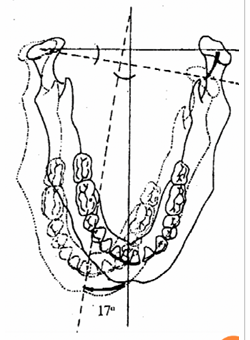3.11 what is masticatalory muscle forces. mastication pressure
1/81
There's no tags or description
Looks like no tags are added yet.
Name | Mastery | Learn | Test | Matching | Spaced |
|---|
No study sessions yet.
82 Terms
what is gnathology
science that focuses on morphology, physiology, pathology and functional integrity of anatomic triad:
TMJ
dental arches
muscles
Priority in gnathology is ensuring proper position of condyles in TMJ fossa
what is occlusodontia?
studies the morphological features and functional changes of the occlusal surface of the teeth and the contact among antagonists.
Aim is to create perfect relationship among the natural and artificial occlusal surfaces
Physiological rest
condyles slightly rotated close to basis of tuberculum
passive position of lower jaw, occurring after swallowing or after pronouncing the words Mississippi or minimum
articulation
Dynamic process involving various actions of the jaw due to muscle contraction
Involves initial contact and articulatory blockages which may lead to occluso-articulating traumatism
occlusion
static contact among all teeth from both dental arches
It is an element of articulating process. In some countries, term dynamic occlusion is used instead of articulation
who introduced central occlusion?
Gysi 1922
describe the muscles, dental arch and condyles at central occlusion
muscle - maximum contraction
Dental arch - maximum teeth contacts, considered priority
Condyles - at basis of tuberculum
who introduced central relation?
McCollum 1926
what is state of muscles, dental arches and condyles at central relation?
muscles - minimum contraction
dental arches - single or multiple weak contacts
condyles - distal position in fossa, allows trasnversal sliding movements. priority given to this position
what is the percentage of centric occlusions that align with centric relation?
40%
60% of the time centric relation is located how distally from centric occlusion? what is this called?
0.46 mm
this movement of TMJ is known as centric sliding
what is the goal of restorative treatment?
to create occlusal contacts in the posterior teeth that stabilise the mandibular position, rather than creating deflective contacts that may destabilise it.
The occlusion should be in harmony with optimum condylar position, which is centric relation. This position is considered the most orthopedically stable position.
whcih position is considered the most orthopedically stable position?
centric relation
who introduced myocentric occlusion?
Janckelson in 1990
state of muscles, dental arches and condyles in myocentric occlusion?
muscles - bilateral, uniform contraction, but not maximum. Priority is given
Dental arches - multiple weak contacts in distal area
Condyles - upper middle position. CR-MO-CO alignment
what is state of muscles, dental arches and condyles in utmost distal occlusion?
muscles - forced maximum retraction
dental arches - few weak contacts
condyles - utmost distal position in fossa, transversal sliding movements cannot be done
which occlusion is considered clinically insignificant due to TMJ discomfort and patient?
Utmost distal occlusion
when is the term central position used?
general statement when the exact position of the mandible is uncertain. not precise but practically significant
what does central psoition refer to?
could refer to CO,CR or MO
state of muscles, dental arches and condyles in central position
position of condyles, dental arches and muscle tone are not precisely determined
whoc introduced morphological occlusion?
Angle in 1899
what is morphological occlusion based on and what are the types?
bases on position of the first molars
Neutrocclusion, distocclusion and mesiocclusion
who introduced perfect occlusion?
A. Filtchev in 1990
what are the types of perfect occlusion?
Neutrocclusion
multiple dense contacts in CO
ultimate occlusion variants - canine guidance, group function, balanced occlusion
edge-to-edge occlusion
CO=CR
No trauma
describe multiple dense contacts in Co of perfect occlusion
In Co, multiple solid contacts between teeth
Number and density of contacts increase distally
Last couple of anatgonists have maximum number of contacts
describe occlusion variations of perfect occlusion
In perfect occlusion there can be different occlusion on left and right side:
Canine guidance in young patients
Group function or unilateral balance occlusion in mature age
Bilaterally balanced occlusion with attrition in grown-up patients
describe edge-to-edge occlusion of perfect occlusion
contact among incisors (canines), which premolars and molars are in distocclusion (not in contact)
describe no traum in perfect occlusion
no preliminary contacts, occluso-articulating blockages or pathological changes in the periodontium, muscles or TMJ
No trauma or negative impact on oral structure
what are the 3 recognised concepts that describe the manner in which teeth should and should not contact with the various functional and excursive positions of the mandible (organisation of occlusion)?
Bilateral balanced occlusion
Unilateral balanced occlusion - group function
Mutually protected occlusion
what is bilateral balanced occlusion based on?
work of Von Spee and Monson
what does bilateral balanced occlusion dictate?
that the maximum number of teeth should contact in all excursive positions of the mandible
when is bilateral balanced occlusion particularly useful?
in complete denture construction and complete occlusal rehabilitation
what is a con of bilateral balanced occlusion?
results in excessive frictional wear of teeth as a result of multiple tooth contacts that occurred as the mandible moved through its various excursions
what does the unilateral balanced occlusion (group function) consist of?
all working side teeth are in contact in lateral excursion
Teeth of non working side are contoured so free of contact
Group function of teeth one working side, distributed occlusal load
Absence of contact on non working side prevents those teeth

which is obvious advantages of unilateral balanced occlusion?
maintenance of occlusion
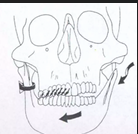
what is mutually protected occlusion also known as ?
canine-protected occlusion or organic occlusion

what is theory behind mutually protected occlusion?
in patients with healthy gums and minimal tooth wear, the arrangement of the teeth allows the anterior teeth to overlap, preventing the posterior teeth from making contact during jaw movements.
This separation from occlusion is called disocclusion.

what is important for a mouth to have to have mutually protected occlusion?
healthy anterior teeth

what should be done if there is anterior bone loss or missing canines (unable to do mutually protected occlusion)?
mouth should be restored to group function or unilateral balance

what is the goal of treatment for molar disocclusion?
in placing occlusal restorations, too produce a posterior occlusion with buffer space that equals or surpasses the deviation resulting from natural variations found in TMJ
what is the average angle of inclination of condylar path?
30.4 (33-40) degrees with the horizontal refence line
what is the effect on cusp heigh is protrusive inclination is steep?
if protrusive inclination is steep - cusp heigh may be longer
If protrusive inclination is shallow - cusp heigh must be shorter
Condylar path also affect—— and ——- directions
Ridge and groove directions are affected by the condylar path
how do the lower front teeth move during protrusive movements?
they move forward and downward along the concave surface of supper front teeth
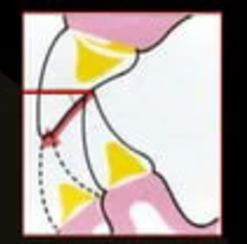
what is protrusive incisal path?
the path folled by incisal edge of lower teeth from maximum intercuspation to edge-to-edge occlusion
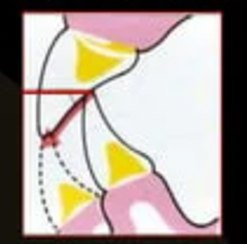
what is the range for inclination of protrusive path?
40-50 degrees
what is anterior guidance?
In protrusive movement of the jaw, the lower front teeth move forward and downward along the concave surface of the upper front teeth.
Evidence suggesting that condylar inclination and anterior guidance are linked or dependent factors
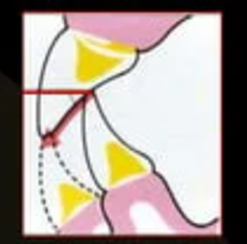
what is condylar guidance?
Inclination of condylar path during protrusive movements can vary from steep to shallow in different positions.
Evidence suggesting that condylar inclination and anterior guidance are linked or dependent factors
what is muscle force?
energy generated from muscle contraction
what is the directions of muscle force?
vertical
horizontal
oblique (including physiological force of Tylman)
whata re muscles involved in mastication?
masseter
buccinator
temporalis
lalteral and medial pterygoid
what did Veber (1836) find out about muscle force?
1cm section of muscle can generate a force of 98N (equivalent to 10kg)
what is abolute muscle force (PA) during normal physiological activity and during chewing?
during normal physiological activity is approximately 390kg.
During chewing, the muscle force (Pm) ranges from 110-120kg.
how can specific chewing force (Ps) be calculated?
Ps = Pm/L
where L represents the lever arm.
Ante’s Law
The total periodontal membrane area of the abutment teeth must be equal or larger than that of the teeth to be replaced

Wusrow 1919
Each tooth can compensate DOUBLE of normal physiological pressure!
Balabanov 1970
postulated the so called "'functional-mechanical equilibrium of periodontium" CONCEPT.
what is the ratio needed between total occlusal surface and total periodontal surface for equilibrium to be reached?
2/1 ratio
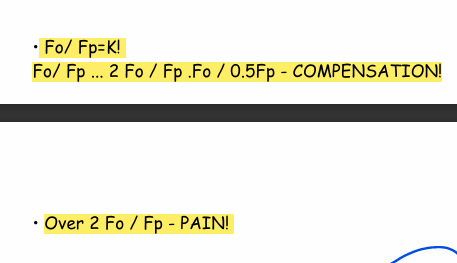
Boyanov equation

what is occlusal pressure and periodontal pressure?
occlusal pressure - specific force Ps/ occlusal area FO
periodontal pressure - resisting force Rs/ periodontal area Fp
what does masticatory unit consist of?
Supporting Part:
Tooth
Periodontal ligament
Bone
Motor Part:
Muscles involved in mastication
Nerve-Sensory Part:
Nerves responsible for sensory input from the masticatory unit
Trophic Part:
Blood vessels that provide nourishment to the masticatory unit
what is masticatory reflex?
pathway from the masticatory unit to the Central Nervous System (CNS) and back to the masticatory muscles.
what does the chewing cycle consist of and what do they come together to form?
chewing cycle consists of two phases: opening and closing
together form the power stroke
what does the chewing sequence involve?
multiple chewing cycles that occur during the process of chewing.
Each time you chew, you go through a chewing cycle, and there are numerous chewing cycles in a complete chewing sequence.
what is movement of frontal teeth when opening mouth to bite?
downward and forward
what is movement of frontal teeth when closing mouth to bite?
going up (edge to edge contact), going up sliding on lingual surface
what is movement of distal teeth when opening mouth to chew?
downward movement
lateral border movement
what is movement of distal teeth when closing mouth to chew?
going up (front border position with cusp against cusp)
Going up sliding on occlusal surface
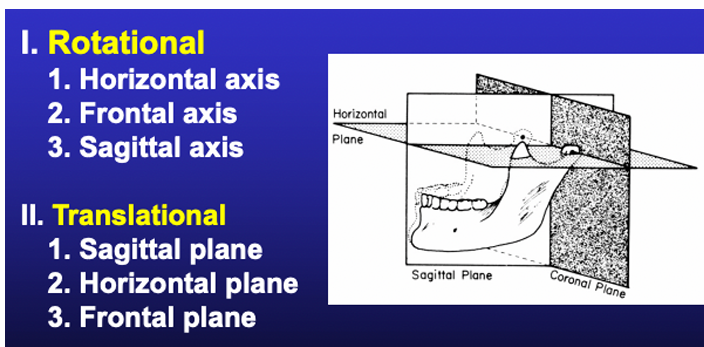
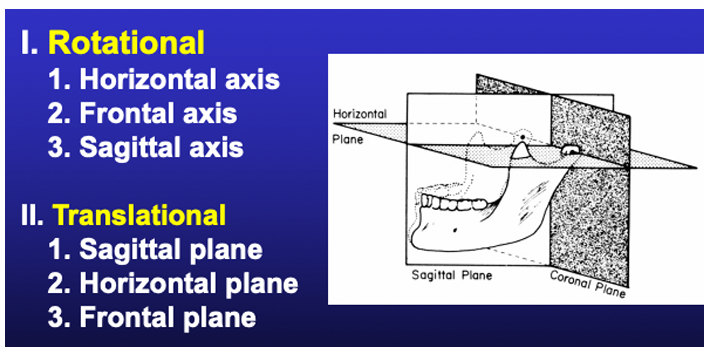
what are movements of mandible according to planes of border movements?
Vertical movement
horizontal movement
sagittal movement
transversal movement

what are the rotation movements of mandible (around axis)?
vertical movement
horizontal movement
sagittal axis of rotation
why does vertical (frontal) movement occur?
Mandibular movement occurs around the frontal axis when one condyle moves anteriorly out of terminal hinge position with the vertical axis of opposite condyle remaining.
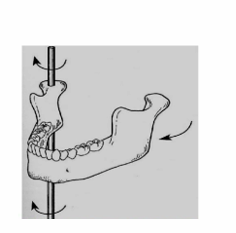
what does horizontal movement of mandible entail?
Mandibular movement around the horizontal axis is an opening and closing motion, known as the hinge movement.
The horizontal axis around which this movement occurs is referred to as the "hinge axis."

what is an example of mandibular activity where a pure rotational movement occurs?
hinge movement

what is the terminal hinge axis?
When the condyles are in their most superior position in the articular fossae and the mouth is purely rotated open, the axis around which this movement occurs is called the "Terminal Hinge Axis."

why does sagittal axis of rotation occur?
Mandibular movement around the sagittal axis occurs when one condyle moves inferiorly while other remains in the terminal hinge position.
Anatomical and mechanical axis of rotation - anatomical axis
connects the midpoints of the two condyle heads.
During rotation, the most prominent point of the condyle head and the top of the chin move on a part of a sphere.
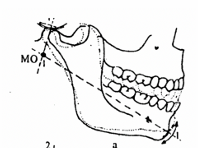
Anatomical and mechanical axis of rotation - mechanical axis
is located at the intersection of the perpendicular lines drawn from the chords of two spheres
The mechanical axis is situated about 2.5 cm behind and under the anatomical axis.

what is movement of horizontal condylar path?
forward and backward
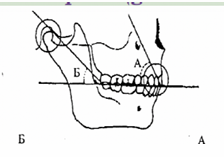
what is condyle path and incisal path angles (both measured in horizontal plane)?
Condylar path - 33-40 degrees (steepness)
Incisal path - 40-50 degrees
in lateral condylar path what is Bennett angle ?
The angle formed between the sagittal plane and the average path of the advancing condyle as viewed in the horizontal plane during lateral mandibular movements
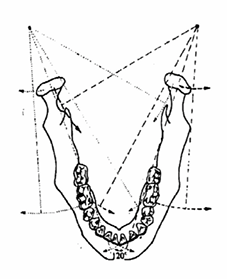
In lateral condylar path, what is gothic angle?
During the transversal movements of the mandible the incisal point outlines two segments left and right.
The angle formed between these segments is called Gothic and is about 120°.
